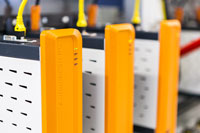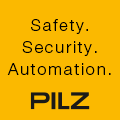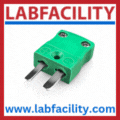
Posted to News on 27th Mar 2017, 00:00
Practical steps towards Industry 4.0
Looking at practical implementations of Industry 4.0, we asked the experts at B&R for examples from their own production environment, and for insight on first steps companies can take along an Industry 4.0 journey.

What today is paraded under the banner of Industry 4.0 has been common practice at B&R’s own production facilities for over a decade. In the Upper Austrian town of Eggelsberg, this truly smart factory has been fully networked since 2006 and is being upgrade all the time.
This means end to end connectivity from order entry to spare parts inventory for the full B&R product portfolio to automatic condition based maintenance instructions issued to technicians via email messaging. Line PLCs communicate directly to the ERP solution throughout the factory. To illustrate the advantages that a smart factory has brought to B&R, let’s focus on a couple particular areas of our production.
Industrial PC production
One of the main streams of productivity improvements provided by Industry 4.0 is mass customisation, which is low volume or batch size one production with a similar cost structure allowed by mass production models. The industrial PC production environment is proof that this is possible. “Mathematically speaking, the customer has more than 250 billion different hardware configurations to choose from,” says Gerald Haas, head of global industrial management at B&R. That’s without considering all of the software options. Most order quantities are in the two to three-digit range.
“The way we’re set up, order quantity is irrelevant,” he continues. “We can produce a one-off item with the same efficiency as a batch of 1000.”
What’s special about the solution is that B&R doesn’t have a collection of subnetworks that are interconnected with varying degrees of efficiency. “What we have is a single, homogeneous network that incorporates every machine and every building automation component as well as the ERP system,” says Haas. That’s what gives the ERP system the ability to control the automated storage and retrieval vehicles in the high bay warehouse. The ERP system sorts the items in the high bay warehouse according to current and forecasted production volumes and triggers reorders when inventory is running low.
By the time a PC order arrives at a worker’s assembly station, all the necessary components are within reach. The worker is guided through the assembly of each PC by on-screen instructions and pick-by-light signals. Workstations are setup ergonomically and the tables are easily adjusted to workers of different heights. Each and every PC is tested repeatedly during and after assembly. They are checked for correct assembly and the CPU and RAM are subjected to functional and stress testing. Only when all tests have been completed successfully does the ERP system release the PC for shipping.
“After all, every product that our customers receive should work flawlessly,” explains B&R’s general manager, Peter Gucher. “Functional testing is nothing we’ve invented, but what is fairly unique is the complete traceability we have for every single product.” Every step in production, every test and every significant component can be traced at any time. This traceability extends throughout the entire lifecycle of the product. Even years down the road, based on nothing more than the PC’s serial number, B&R is able to look up the results of every functional test ever performed on it and clearly identify every component it contains. “This gives our customers an added layer of certainty,” explains Gucher.
On its website, B&R provides a service portal where its customers can look up technical data and order-related information by simply entering their product’s serial number. This includes version information, delivery date, warranty status and much more. “We’re able to save our customers a lot of time and effort this way,” adds Gucher.
Automated data processing
Of course, fully networked intelligent production generates its fair share of data. On large systems, the collected data can quickly reach gigabyte or even terabyte levels. “Automated data processing and analysis is essential to reaching an informed decision,” says Gucher. That’s why B&R collects and evaluates all of its production data using its own APROL process control system. In APROL, parameters such as overall equipment effectiveness (OEE) can be viewed at any time and even compared between production lines, shifts or workdays. “With APROL we always have an eye on our energy consumption as well,” adds Haas, “so we can make immediate corrections when something is wrong.”
B&R sets the bar high when it comes to maintenance, too. Using condition monitoring tools from its own portfolio, B&R is able to determine the ideal timing for maintenance work. This eliminates the waste of replacing parts too early, as well as the risk of waiting too long and damaging a machine. If a key parameter moves out of its defined tolerance, an employee receives automatic email notification and can intervene before the aging component fails and causes an unplanned stoppage.
“For B&R, networked smart factory production has been a reality since 2006,” says Haas. “What for us is business as usual, has since been given a name: Industry 4.0.”
Where to start
While B&R’s own production process can serve as inspiration and confirmation of its capabilities, the company understands that not every factory is in a position to make the kind of changes required to imitate this model from day one. So what is the first step?
Conventional systems that allow for data acquisition, storage and analysis for measuring the performance of production machines can be very costly and time consuming thus minimising the return on investment or payback period. One key metric to consider that many manufacturers are using is overall equipment efficiency, as it encompasses not only machine data but also quality and supply chain.
Measuring OEE or collecting data on new machines can easily be defined as part of the specification for a new machine, but what about all of the brownfield sites? How do you connect a machine that is 30 years old but one that is still producing high value for the business?
Enter stage right, B&R’s Orange Box. This allows a user to either connect to existing PLCs on machines or if the machine does not have a PLC, collect data through some added remote I/O. This information can either than be viewed locally by line on a local HMI or over a network solution in a manager’s office. No PLC programming knowledge is required to configure this solution as it is configured rather via a set of pre-developed screens directly on the HMI. This means the local site electrical team can install and commission the solution without the need of speciality system programmers.
One large global end user in the food and beverage market has found this solution to be extremely effective. By installing B&R’s Orange Box solution the company is able to standardise on the KPIs across its global network of factories. By increasing its OEE by 1% globally across its 436 factories, the company is predicting a €400M increase in profitability. And the ability to measure this easily and consistently is the first step to the factory of the future.
B & R, Southgate Park, Bakewell Road
Broadoak
Orton Southgate
PE2 6YS
United Kingdom
+44 (0)1733 371320





